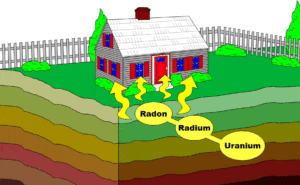
What Is Radon?
Radon is created when uranium found in the soil, rocks, and underground water breaks down. It is colorless, odorless, and tasteless, and travels vertically through holes and cracks in the ground; this gas can sometimes enter homes, businesses, and schools. When inhaled, radon can increase the risk of cancer and result in severe damage to lung tissue.
Radon is the second-leading cause of lung cancer deaths in the United States, second to smoking.[i] It is measured in units of picocuries per liter (pCi/L), and the Environmental Protection Agency (“EPA”) has determined that radon should not be or exceed 4 pCi/L. If such levels are found in a building, the EPA recommends that mitigation measures be taken, and then retesting be done.
This gas is found in many spaces, including outdoor areas. However, the average level of radon outside hovers around 0.4pCi/L and poses very little to no health risk. However, when radon is released indoors, it can build up over time and become a serious health concern to those occupying the space. According to the Agency for Toxic Substances and Disease Registry, children exposed to radon may be twice as likely as an adult to develop lung cancer.[ii] If that same child is also exposed to tobacco smoke, their risk is at least 20 times higher.
Because of this, the EPA recommends that all schools test for radon, but this is not a mandate in most states, including Pennsylvania. Currently, Pennsylvania does not require that school buildings be tested for radon.
Testing and Mitigation of our Homes
There are several types of radon tests on the market today. Some need to remain in your home for two days while others should remain for more than three months. Obviously, the shorter-term test allows for a faster turnaround on results, whereas the long-term test provides a better understanding of your home’s year-round radon level.
Where to find a test kit:
- The US EPA offers a series of links to find free and inexpensive kits. Link here.
- National Radon Program Service. Link here.
- Centers for Disease Control and Prevention website. Link here.
If your home is found to have elevated levels of radon, mitigation measures can be quite simple. It is always recommended that you find a qualified contractor who understands the specific issue with your residence and how to appropriately address it. The EPA has published a user guide that contains some suggestions on how to find an appropriate contractor. This person should make recommendations that are appropriate for the construction of your home. Some mitigation suggestions could range from sealing cracks and openings in the foundation to installing an active subslab suction. The type of technique will have varying results, so it is advised that you review all mitigation options and talk them over with your contractor.
What Can We Do About Our Schools?
We can do several things to ensure that our schools are radon-free. First, ask your school district to see if testing has been conducted. In 2018, Healthy Schools PA reached out to all the school districts in the Commonwealth to see whether or not they test for radon, and many districts did not reply to this request. Of those who responded to the ask, 31% said they did test for radon, and 28% of those who did a test reported having a limit over 4 pCi/L.
Second, if testing has not been done, ask them to test using a certified individual. It could be helpful to inform them that there are grants available to pay for such testing—for example, the 1000 Hours a Year program.
Third, if a new school is being constructed, ensure that the building is and will remain radon-free.
Lastly, we can contact our local legislators and ask them to support and vote for specific legislation which would require regular radon testing in schools. Currently, State House Representative Tim Briggs has introduced HB 790, which would require schools test for radon every five years and any new school building (or remodeled building) be tested in the first 19 months of being occupied. The bill would also require that parents be notified in writing of the level of radon at their child’s school.
[i] The State of Environmental Health in Southwestern Pennsylvania Schools, report conducted by Healthy Schools PA, September 2018, 1-52, at 40.
[ii] Radon in Schools? Bill Would Begin to Mandate Testing in Radon-Dense Pa., Kaity Kline, WHYY, Keystone Crossroads, April 15, 2019.

